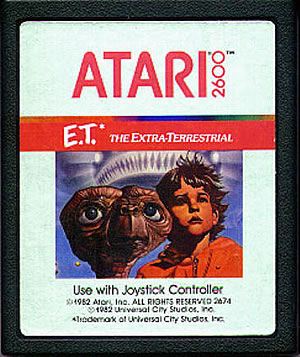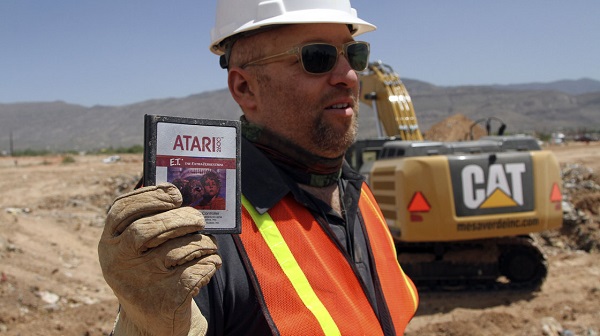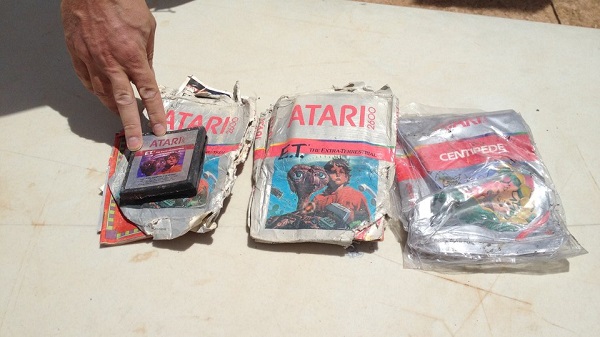In a development straight from the ‘Who’da Thunk It?’ file, it appears that screenwriter Zak Penn may have confirmed the most enduring myth in videogame history:
As we all know, Penn is directing a documentary co-produced by Fuel Industries and Microsoft about the much-rumoured dumping of millions of copies of the Atari 2600 E.T.: The Extra Terrestrial game in the New Mexico desert following its spectacular failure in the marketplace. As part of the shoot a much-publicized dig was arranged at a landfill in Alamogordo, N.M., the rumoured location of the mass grave: a rumour that has fallen into legend amongst gamers. Judging by the announcement on Saturday that they have already found hundreds of crushed copies of the game still in their packaging, it seems that the legend may actually be true.
 It’s a story that has kept people fascinated through thirty years of rumours, debunkings and re-bunkings, for a variety of reasons. E.T. was one of the first examples of the kind of massively hyped movie licensed games that would soon become a permanent aspect of the industry, and its release was overshadowed by a variety of severely unfavourable circumstances. The first of these, which was to be Atari’s first and most crucial mistake, was to overdo the production run, with an alleged four million copies produced in expectation of massive sales that didn’t eventuate.
It’s a story that has kept people fascinated through thirty years of rumours, debunkings and re-bunkings, for a variety of reasons. E.T. was one of the first examples of the kind of massively hyped movie licensed games that would soon become a permanent aspect of the industry, and its release was overshadowed by a variety of severely unfavourable circumstances. The first of these, which was to be Atari’s first and most crucial mistake, was to overdo the production run, with an alleged four million copies produced in expectation of massive sales that didn’t eventuate.
Several factors have been cited for the game’s commercial failure, including the rise of rival game machines eroding the virtual monopoly Atari had enjoyed in the 2600’s first years. It has also been speculated that Atari’s aggressive manoeuvres towards distributors – cancelling many existing contracts and attempting to force distributors to re-negotiate in anticipation of the Christmas 1982 sales period – caused many to refuse to play ball. limiting distribution options for E.T .
However, these issues could have been surmounted if the game was actually playable by any reasonable standards. E.T.’s awfulness is now part of the pantheon of gaming legend, but hearing about it is one thing: I was one of those kids who received a copy of this thing on Christmas Day 1982, only to be met with an experience that was not just bitterly disappointing but absolutely nonsensical. The game was borderline unplayable. Sure, it had set goals and mechanics that allowed you to achieve those goals, but it’s not like the blocky mess onscreen – that was barely recognizable as anything relating to E.T. in the first place – made any effort to actually communicate these goals to you.
I remember it taking months to even get my head round escaping the random potholes you keep falling into, with its bizarrely twitchy float mechanic achieved by extending E.T.’s neck and apparently hoping for the best, since the ludicrously strict collision detection would often send you hurtling back to the bottom again as soon as you were (supposedly) clear. All this levitating quickly became distinctly unfun as it consumed your health – as did walking. Anywhere. And if the actual act of movement trying to kill you wasn’t bad enough, you also had the annoyingly hard to dodge agent and scientist bearing down on you like two incredibly blocky homing missiles every ten seconds. Thankfully, you could avoid them by falling down a pothole. The catch? You’ve fallen down another bastarding shitting pothole.
Seriously, people call Dark Souls masochism? It’s nothing compared to this and I somehow played this thing for months on end. I can only surmise that my seven-year-old brain could only take it because it simply hadn’t developed enough yet to be able to break. After the better part of a year I worked out how to play the game and was able to finish it and experience its ultimate punchline. Below is a video of some presumably adult, and therefore insane, guy playing E.T. to completion (SPOILER: E.T. goes home):
Two and a half minutes. That’s it. Months of climbing out of then immediately falling into the same hole eighty million times in a row, all for a game that when played correctly, takes less work than a toasted sandwich. No wonder it didn’t want to explain what was going on, because apparently nothing was.
It’s not as if Atari had chucked this games at their B-team, either. The job went to Howard Scott Warshaw, the man who produced the classic Yars Revenge and the popular adaptation of Raiders of the Lost Ark for Atari. Unfortunately, Warshaw was hired in July 1982 and given a deadline of September 1st so that the game could be ready for its Christmas release. Even by the standards of the time, this was an insanely short window to produce a video game, especially one that would facilitate Warshaw’s unconventional vision of the gameplay (Which was originally meant to be much bigger and adopt a semi-three-dimensional cube-like structure).
 What came out at the other end was perhaps the archetypal rush-job in videogames, a borderline-unplayable mess of bugs, half-realized concepts and erratically-programmed controls that, much like the titular alien himself, was left bloated and half-dead in the middle of nowhere almost as soon as it arrived. Although it managed to sell some 1.5 million copies over Christmas, sales hit a brick wall the second word of mouth on what the game was actually like went around. This left something between 2.5 to 3.5 million copies sitting around unsold and eventually sent back to Atari by frustrated retailers. This debacle, along with Atari’s disastrous 2600 conversion of Pac-Man, are commonly cited as the start of the great videogame crash of the early 1980s and the poison pill that killed the Atari that gave many of us our first introduction to videogames.
What came out at the other end was perhaps the archetypal rush-job in videogames, a borderline-unplayable mess of bugs, half-realized concepts and erratically-programmed controls that, much like the titular alien himself, was left bloated and half-dead in the middle of nowhere almost as soon as it arrived. Although it managed to sell some 1.5 million copies over Christmas, sales hit a brick wall the second word of mouth on what the game was actually like went around. This left something between 2.5 to 3.5 million copies sitting around unsold and eventually sent back to Atari by frustrated retailers. This debacle, along with Atari’s disastrous 2600 conversion of Pac-Man, are commonly cited as the start of the great videogame crash of the early 1980s and the poison pill that killed the Atari that gave many of us our first introduction to videogames.
What happened next would become gaming’s greatest urban legend. In September 1983 the Alamogordo Daily News reported that between ten and twenty semi-truckloads of Atari games and systems from a storehouse in El Paso, Texas were crushed and buried at the local landfill. Over the next three decades denials would abound, leading to new claims and further debunkings, but no matter what it always seemed that there was someone new coming forward to rekindle the landfill story. The announcement of the Fuel/Microsoft documentary was received with no small degree of skepticism: I mean, how often do these kinds of things actually bring up anything except the same old theories in new packaging? However, the announcement of this find is the first sign that maybe this time we’ll be getting a definitive answer. Interestingly, the copies were found with the cartridges still in their packaging along with copies of other games such as Centipede, which may suggest the kind of mass dumping of unwanted goods that the myth describes.
Of course, for the myth to be truly busted one or two copies are not enough: like any good myth the actual number of buried copies tends to vary wildly, from sources claiming anything from thousands to hundreds of thousands, to the whole two to three million . A wholly satisfying result would need to see Penn and company unearthing a haul to match these numbers to truly put the legend to rest. That said, this discovery at the very least confirms that fully-packaged copies of E.T. do exist in the Alamogordo landfill.
Like any good myth, however, perhaps it really isn’t about the details but the meaning of the whole that’s really important. The E.T. landfill story is for many people loaded with nostalgic value, not just for the film but also that first discovery that videogame adaptations can sometimes fail to replicate the experience the source provides. It’d be a stretch to say that the confirmation of the myth would provide closure, but maybe, if it really does turn out to be true, it’ll fill out the story in some strange way for those of us who were there on Christmas Day 1982, probably being told off by our parents for exclaiming ‘What the fuck?’.

